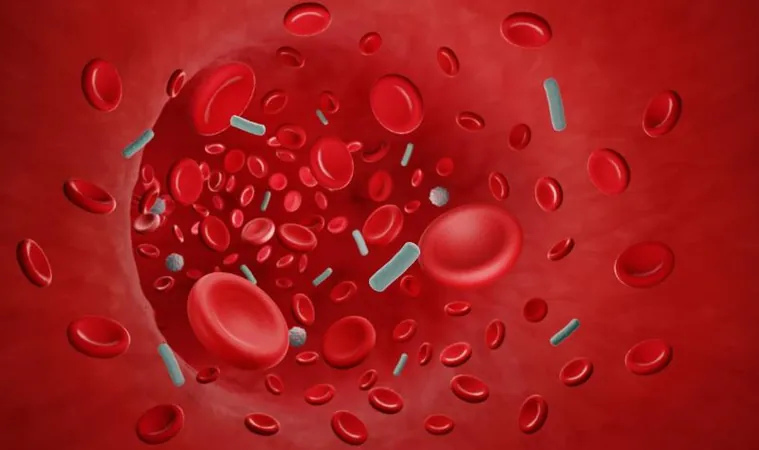
Groundbreaking Study Reveals 7-Day Antibiotic Treatment Effective for Bloodstream Infections!
2024-11-20
Author: Jia
In a pivotal finding for the medical community, a recent randomized controlled trial has demonstrated that a 7-day antibiotic treatment regimen is just as effective as the traditional 14-day course for patients suffering from bloodstream infections.
This study, involving a staggering cohort of over 3,600 hospitalized patients, was published in the prestigious New England Journal of Medicine and marks a significant shift in antibiotic treatment protocols.
The research, known as the BALANCE (Bacteremia Antibiotic Length Actually Needed for Clinical Effectiveness) trial, was conducted across 74 hospitals in seven different countries.
It focused on patients who had bloodstream infections caused by various pathogenic bacteria. These findings contribute to a growing body of evidence supporting shorter antibiotic treatments as effective alternatives for a range of bacterial infections.
The Urgency of Addressing Bloodstream Infections
Bloodstream infections, classified among the most dangerous bacterial infections, are responsible for approximately 2.9 million deaths globally each year.
Traditionally, the treatment duration for these infections has been set at 14 days or longer due to concerns that shorter treatment could result in clinical failure or relapse of the infection.
Led by researchers from the University of Toronto, this study aimed to scrutinize the safety of a shorter duration of treatment by comparing death rates after just 7 days of antibiotics against those who received the conventional 14-day therapy.
The researchers also contemplated that a reduced duration of antibiotic use could minimize adverse side effects and the risk of developing antibiotic-resistant infections.
Key Findings and Implications
The trial randomized 3,608 patients—with a median age of 70 years—into two groups receiving either 7 or 14 days of antibiotic treatment.
Notably, 55% of participants were in the intensive care unit (ICU), and the majority had infections originating from the urinary tract.
Excluded from the study were patients with severe immunosuppression or those who tested positive for Staphylococcus aureus.
The primary aim of the study was to assess overall mortality within 90 days following the treatment.
Remarkably, 14.5% of patients in the 7-day group succumbed within this period, compared to 16.1% in the 14-day group—a difference that met the criteria for noninferiority.
This indicates that shorter treatment does not compromise patient safety and may even contribute to more effective patient care.
A Major Shift Towards Shorter Treatments?
With the healthcare landscape increasingly focused on combating antibiotic resistance, the implications of this study are profound.
The researchers anticipate that adopting a 7-day treatment strategy could significantly reduce medication costs, facilitate easier healthcare management, and lower the risk of developing resistant bacterial strains—benefits that resonate widely in healthcare systems around the world.
Interestingly, some patients in both groups received treatment for longer than assigned, yet even an analysis of these deviations confirmed that the 7-day therapy remained non-inferior in effectiveness compared to the longer course.
Looking Ahead: A Call for Further Research
The BALANCE trial follows three other studies, all of which corroborated the findings that a 7-day antibiotic treatment is effective for bloodstream infections.
However, the BALANCE trial stands out due to its larger sample size and inclusion of critically ill patients—a crucial factor in evaluating treatment efficacy.
The authors emphasize the potential of shorter antibiotic courses in promoting better patient outcomes while simultaneously addressing the dire need to combat antibiotic resistance.
As researchers call for further studies, they highlight the necessity of individualizing antibiotic treatment based on patient needs, ultimately enhancing healthcare outcomes.
This groundbreaking research could not only transform treatment protocols but also sets the stage for a more sustainable approach to antibiotic use—changing the future of how we treat some of the most dangerous infections!




 Brasil (PT)
Brasil (PT)
 Canada (EN)
Canada (EN)
 Chile (ES)
Chile (ES)
 España (ES)
España (ES)
 France (FR)
France (FR)
 Hong Kong (EN)
Hong Kong (EN)
 Italia (IT)
Italia (IT)
 日本 (JA)
日本 (JA)
 Magyarország (HU)
Magyarország (HU)
 Norge (NO)
Norge (NO)
 Polska (PL)
Polska (PL)
 Schweiz (DE)
Schweiz (DE)
 Singapore (EN)
Singapore (EN)
 Sverige (SV)
Sverige (SV)
 Suomi (FI)
Suomi (FI)
 Türkiye (TR)
Türkiye (TR)